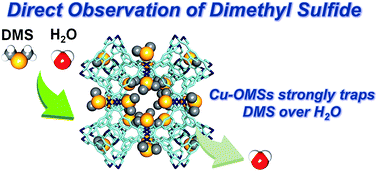Direct observation of dimethyl sulfide trapped by MOF proving efficient removal of sulfur impurities†
Abstract
Here, we report the adsorptive removal of trace amounts of dimethyl sulfide (DMS) using metal–organic frameworks (MOFs). Cu2+-based MOFs with open metal sites (OMSs), [Cu3(btc)2] (HKUST-1), where btc = 1,3,5-benzenetricarboxylate, and without OMSs, [Cu2(bdc)2(dabco)] (Cu-JAST-1), where bdc = 1,4-benzenedicarboxylate and dabco = 1,4-diazabicyclo[2.2.2]octane, were investigated for the removal of DMS to compare their performance with that of Ag–Y zeolite, which is currently widely used in industry. HKUST-1 exhibited a considerably higher adsorption capacity for DMS than the other adsorbents, which was confirmed by breakthrough measurements. The adsorption state of DMS with HKUST-1 was directly revealed by single-crystal X-ray diffraction (SXRD) analysis and in situ Raman spectroscopy. In addition, it was shown that DMS can be removed by HKUST-1 even under humid conditions.



 Please wait while we load your content...
Please wait while we load your content...